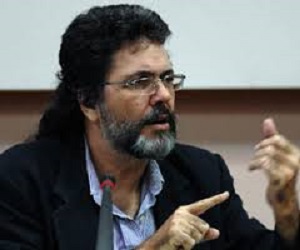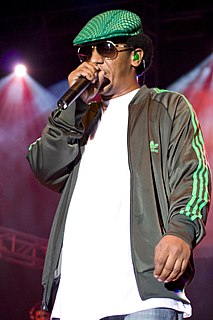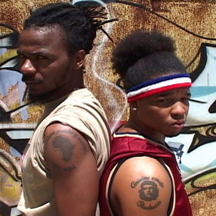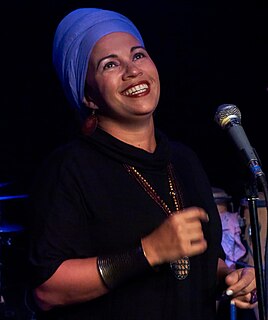
The Cuban Rap Agency (Agencia Cubana de Rap) is an industry subsidized by the Cuban government aimed at aiding Cuban hip hop artists in attaining radio exposure and recording contracts. Founded in 2002, the Cuban Rap Agency seeks out talented Cuban hip hop artists in order to promote hip-hop in Cuba. [1]
Hip hop music arrived in Cuba via radio and TV broadcasts from Miami. During the 1980s hip hop culture in Cuba was mainly centred on breakdancing. But by the 1990s, with the collapse of the Soviet Union and the onset of the Special Period, young "raperos" were seeking ways to express their frustrations.

Hip hop or hip-hop, is a culture and art movement that began in the Bronx in New York City during the early 1970s. The origin of the word is often disputed. It is also argued as to whether hip hop started in the South or West Bronx. While the term hip hop is often used to refer exclusively to hip hop music, hip hop is characterized by nine elements, of which only four elements are considered essential to understand hip hop musically. The main elements of hip hop consist of four main pillars. Afrika Bambaataa of the hip hop collective Zulu Nation outlined the pillars of hip hop culture, coining the terms: "rapping", a rhythmic vocal rhyming style (orality); DJing, which is making music with record players and DJ mixers ; b-boying/b-girling/breakdancing (movement/dance); and graffiti. Other elements of hip hop subculture and arts movements beyond the main four are: hip hop culture and historical knowledge of the movement (intellectual/philosophical); beatboxing, a percussive vocal style; street entrepreneurship; hip hop language; and hip hop fashion and style, among others. The fifth element, although debated, is commonly considered either street knowledge, hip hop fashion, or beatboxing.
The CRA provides a state-run record label named La Fabri-k to help promote hip-hop on the island. The two main groups that make up the La Fabri-k label are Obsesion and Doble Filo. An important part of their style is live musicianship, underlining a mixture of traditional percussion, guitar, violin, cello, saxophone and piano all layered under rhyme.
Doble Filo is a Cuban hip-hop band formed in 1995 and composed of Yrak Saenz and Edgaro Gonzalez. The band, which is often compared to Dilated Peoples and The Amorphous, won the Alamar rap Festival's Grand Prize in 1996.
The CRA is an example of the growing nationalization of rap and music in general in Cuba. Indeed, in 1999, Abel Prieto, the minister of Culture, declared rap to be " an authentic expression of Cuban culture". [2]
Nationalization is the process of transforming private assets into public assets by bringing them under the public ownership of a national government or state. Nationalization usually refers to private assets or assets owned by lower levels of government, such as municipalities, being transferred to the state. The opposites of nationalization are privatization and demutualization. When previously nationalized assets are privatized and subsequently returned to public ownership at a later stage, they are said to have undergone renationalization. Industries that are usually subject to nationalization include transport, communications, energy, banking, and natural resources.

Abel Prieto Jiménez is a Cuban politician. Abelito, as he was called as a child, is the son of Abel Prieto, a Cuban educator who for several years pre and post Castro ran a preparatory school on Pinar Del Rio. From 1997 to 2012 and from 2016 to the present he has served as Minister of culture. In March 2012 he was appointed as advisor to Cuban President Raul Castro.
Skeptics charge the organization with the marginalization of hip-hop in Cuba. Intrinsic to the Cuban Rap Agency's mission of increasing exposure of Cuban hip-hop is an emphasis on the commercialization of the music. This in addition to the growing materialism in Cuba has put pressure on artists signed by the agency to adopt a more commercially viable sound such as reggaeton. [3] According to journalist Jessica Thurston of The Tartan , the Cuban Rap Agency leads hip-hop artists to "abandon their ideals and minimize the ability of any group to cause change." The agency's growing number of reggaeton artists and decreasing number of hip-hop artists causes concern with the shift in messages that these two genres of music represent. Hip-hop in Cuba was embraced so quickly because contained a revolutionary social message which to many resonates with the Cuban revolution. [4] On the other hand, Thurston characterizes reggaeton as the genre that "celebrates the trivial lifestyle of bars, dancing, and objectifying women". [5] Many view the Cuban Rap Agency as a threat to the future of underground hip-hop in Cuba. [6]
Reggaeton is a music style which originated in Puerto Rico during the late 1990s. It is influenced by hip hop and Latin American and Caribbean music. Vocals include rapping and singing, typically in Spanish.

The Tartan, formerly known as The Carnegie Tartan, is the original student newspaper of Carnegie Mellon University. Publishing since 1906, it is one of Carnegie Mellon's largest and oldest student organizations. It currently has over 170 student members, who contribute on a weekly basis. It is funded by advertisements and the university's student activities fee.
The Cuban Rap Agency rejects these accusations, claiming that the CRA is beneficial for the hip-hop community in Cuba. CRA director Susan Garcia Amorós asserts that the rappers endorsed by the organization "have rapped their own way." Journalist Antonio Paneque Brizuela of La Revista Cubana de Hip Hop interprets this quotation to mean that CRA artists have impacted the development of other musical styles. [7]
Upon its initiation, the CRA consisted of three major rap groups: Cubanitos 2002, Alto Voltaje and Cubanos en la Red. The number of recording artists that existed beneath the CRA's jurisdiction fluctuated until 2004. At that point, many "rap" and "hip-hop" artists had withdrawn from the organization, providing for an unprecedented distribution of reggaeton. A rift gradually formed between the CRA and the more hip-hop centered Asociación Hermanos Saíz. The AHS, however, is not a government endorsed institution, and instead a function of the Union of Young Communists. The AHS maintains a similar critique to that of Jessica Thurston, openly criticizing the genre at the 8th Congress of the Union of Young Communists in 2005. [8]
The early/initial visible roots of hip hop in Cuba are believed to have emerged through break dance competitions or battles that were seen on the streets of Cuba. The continuous repetition of break dance battles were one of the strong channels or pioneers of the hip hop culture in Cuba. Some sources state that hip hop in Cuba strongly emerged in the early nineties as a way out due to the termination of the numerous subsidies that were received by the country through the Soviet. All the above-mentioned pertaining to Cuban hip hop is vital however, none of it would have been successful without the presence of one of the two Cuban Institutions namely, Asociacion Hermanos Saiz and Agencia Cubana de Rap. Asociacion Hermanos Saiz and the latter are the two initial Institutions that were funded by the Cuban Government with the major motive of promoting Rap/hip hop in Cuba more so, hip hop groups in Cuba.








